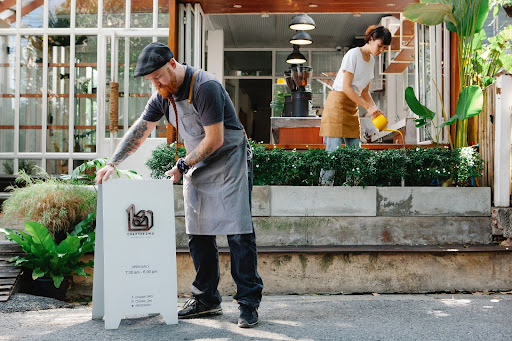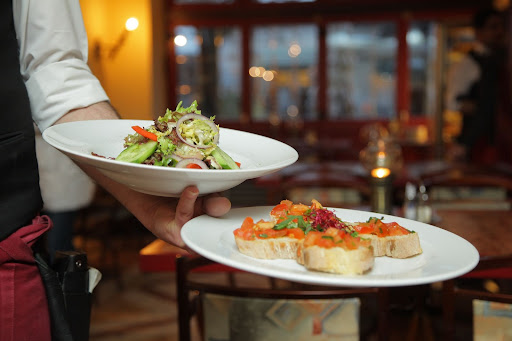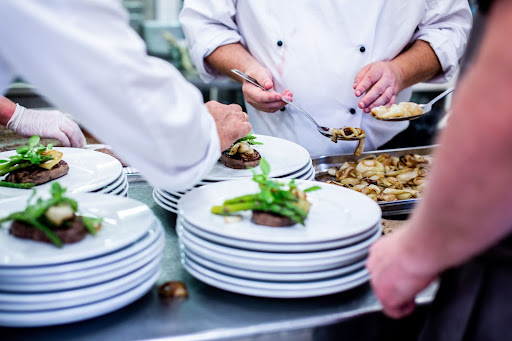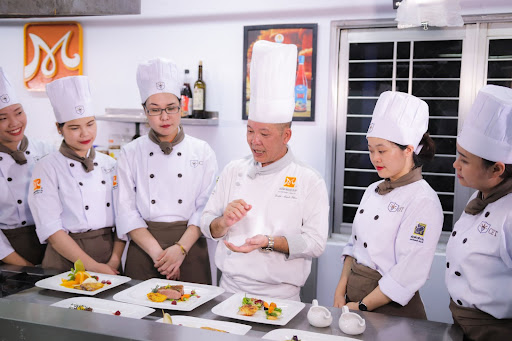Restaurant owners and managers often have so much going on, it’s hard to prioritize restaurant staff training. You might feel like your time is better spent looking for ways to improve your approach to customer service, experiment with your menu, or increase your profit margins.
And with restaurant staff turnover rates at 70%* — higher than most other industries — putting too much time into training a steady stream of new team members may feel discouraging
But a restaurant training program isn’t a waste of time. In fact, there are tried-and-tested actions you can take to help you retain great employees, provide a great customer experience, and ultimately build your restaurant’s local reputation. That’s why we created this guide for restaurant staff training, where we’ll talk about:
- The restaurant training topics you should cover
- Practical tools and techniques for a better training experience
- How to design your training program from start to finish
*Forbes, 2022
Why you need a restaurant staff training plan
You may be wondering how much time and resources you should invest into training when you’re not sure how long your employees will stick around. But top-notch training pays off in the long run. Here’s how.

Increase employee productivity
You can’t expect employees to meet your expectations if you don’t use a training program to define and explain your performance standards.
When training new hires, specify what productivity looks like for your restaurant so you’re setting clear guidelines about what success looks like to you. Here are some examples of how you can help staff members think about productivity in more concrete terms:
- How many guests they should serve per shift
- How many customer checks they should handle per shift
- Upsells (and how much they’re worth in dollars) per shift
- Server errors per customer (how many mistakes a server makes with an order)
Avoid staff conflicts
The restaurant industry involves fast-paced, high-stress work that inevitably leads to staff conflicts. Knowing that, how many kinds of conflicts can you anticipate and address preemptively in your training program? Don’t wait for disagreements between staff members to arise. Training can help you get ahead of:
- Employee interdependence conflicts: These arise when one person can’t do their job until another employee has done theirs. For example, a server has to wait for a busser to clean off a table before they can seat and welcome the next customers.
- Problem-solving conflicts: This often happens when two employees can’t agree on a solution to a problem.
- Personality conflicts: These happen when two employees have clashing personalities and find it challenging to work together and get along, even on the best of days.
Reduce employee turnover
With one of the highest turnover rates of any industry, you may worry that your restaurant will suffer the same outcome. But you can combat turnover by making your restaurant an ideal place to work — and training your employees well so they enjoy doing their jobs and stick around.
But how does adequate training help reduce turnover?
- Training makes employee goals specific and clear. Staff members won’t have to guess what it means to perform well. All they have to do is measure their performance against clearly defined guidelines.
- Managers have a better understanding of their employees’ roles. When managers know what’s expected of team members, they can give them more specific, constructive guidance and feedback.
- Your workforce will be more skilled, so you’ll want to keep them around. And you’ll know when it’s time to let someone go because you will have well-established expectations and standards.

Improve guest experience
Your guest experience should be at the center of what you do. But for new restaurant hires — especially servers, hosts, bartenders, and managers — it can take time to learn what good customer service looks like without any first-hand experience. With an interactive training program, employees have the chance to:
- Role play during their orientation and training
- Shadow one of your more experienced employees for the first few days
- Work a couple of supervised shifts
- Lean on a mentor for the first month
Generate more sales and improve your bottom line
Your client-facing staff members play a particularly important role in bringing customers into your restaurant and keeping them coming back. For instance, customers who had a good dining experience tend to share their feelings via Google reviews and word of mouth, spreading the good word about your restaurant.
But client-facing employees don’t just attract customers — they know how to generate sales effectively. And servers with excellent sales capabilities are made, not born. They get there with training, which is why you need to cover sales skills in your training program.
For example, well-trained servers upsell by:
- Making suggestions and recommendations
- Educating customers on daily specials and the menu
- Encouraging customers to get a full bottle of wine rather than individual glasses
- Bringing by a dessert menu before customers ask for the check
- Offering guests coffee or after-dinner drinks
Restaurant staff training topics you should cover
For your training program to really provide value for your employees and customers, it needs to be as detailed as possible. Here’s some of the information we recommend including.

Etiquette and dress code guidelines
For the most part, you can determine your etiquette guidelines based on your restaurant atmosphere and style. If you run a casual dining restaurant, for example, you may put more focus on the food and less on formal server etiquette like serving guests from the left.
And you’ll choose your dress code similarly. You may decide your servers should wear all black or the same color aprons.
Here are a few general etiquette and dress code guidelines you may want to implement:
- Shirts, pants, and shoes should always be clean and free of rips or holes.
- Always seat any guests present, even if their entire party hasn’t arrived yet.
- Instead of saying, “I don’t know,” when a guest asks a question, say, “I’ll find out,” or “I’ll ask the chef.”
- Never touch a customer, even if you’ve spilled something on them.
- Never blame your coworkers for issues with a meal or experience. Just address the problem.
- Always be attentive to a guest that needs assistance, even if they’re not seated at your table.
- Be friendly and welcoming to customers.
Customer service
Customer service training is essential for any hospitality business, especially front-of-house staff. But every restaurant also has to define what excellent customer service looks like for their specific establishment.
So, let’s take a look at some examples of training points for bussers, servers, and bartenders.
Bussing
- Know your tables well and always pay attention to the parties sitting at them.
- Watch the door or hosting area so you know as soon as guests arrive.
- Try to keep tables as clean and clutter-free as possible throughout meals. Clear appetizer dishes before main courses arrive.
- Make regular rounds of your tables to see if they need anything. Refill water and drinks when necessary.
- Check in with your server regularly to see if they need any assistance.

Serving
- Don’t let your table wait too long for service when they arrive or after they ask for the check.
- Greet customers warmly.
- Always bring guests’ dishes at the same time. Don’t let one guest wait while others begin eating.
- Don’t touch the rim of any glass when serving or taking away drinks.
- Always be on the lookout for small things customers may need, like more napkins, condiments, another menu, or drink refills.
- Always ask if a guest is finished before cleaning a plate.
- Recognize regulars and try to remember their favorite orders.
Bartending and wine service
- Greet guests at the bar in a friendly way and make small talk with them.
- Become familiar with your alcoholic products and brands and know what you’re selling.
- Make suggestions for customers who aren’t sure what they’d like to order (and suggest a mid-priced option rather than cheaper or more expensive wines, liquors, and spirits).
- Keep the bar clean, organized, and free of glasses and clutter.
Compliance and food safety
You should familiarize and train your entire restaurant staff on:
- Food safety: Walk your new staff members through the Food and Drug Administration’s (FDA) Food Code recommendations for safe food handling practices that prevent the spread of foodborne illnesses. You’ll need to do this to make sure you pass regular health inspections.
- Creating a safe work environment: Educate your employees on the Occupational Safety and Health Administration (OSHA) safety regulations they need to follow to keep a hazard-free workplace.
- Promoting an inclusive workplace: Emphasize the importance of the Equal Employment Opportunity Commission (EEOC) guidelines for creating a discrimination-free workplace.
Restaurant-specific knowledge
Here are some of the basic day-to-day procedures you should cover in your restaurant training. It’s best to keep these tasks on a checklist everyone can reference easily.
Opening and closing procedures
Opening procedures:
- Turn on your lights.
- Turn on your music.
- Make sure everyone clocks in for the day.
- Make sure you have receipt paper stocked in your register. Restock if necessary.
- Open your register and count out the money for the day.
- Sweep or vacuum the floors.
- Make sure your server stations are fully stocked with glassware, silverware, and napkins.
- Fill your water pitchers.
- Check your upcoming reservations for the day. Take note of any special requests.
- Make sure all servers know the daily specials and how to talk about them to customers.
- Make sure your bathrooms are clean and soap and paper towels are stocked.
- Turn on or put up your open sign.
Closing procedures:
- Turn off or take down your open sign.
- Wipe down and sanitize menus, tables, booths, booster seats, and high chairs.
- Refill salt, pepper, and condiments.
- Empty water pitchers.
- Dry off any freshly cleaned dishes.
- Fold napkins and tablecloths.
- Take out the trash and replace garbage bins with new bags.
- Sweep, wipe down, and sanitize bathrooms.
- Print or email out your end-of-day report for the manager or owner.
- Make sure all registers are closed out.
- Close all card batches for payment processing.
- Sweep, vacuum, and mop floors.
- Make sure no food is left out of the refrigerator.
- Make sure your refrigerator is set to 40℉.
- Leave relevant notes for staff members that’ll come in the next day.
- Make sure all employees clock out.

Food handling and storage procedures
Print out these federal guidelines for food safety, put them in your training manual, and place a copy on display in the necessary areas:
- A general guide to food handling and sanitation
- Food safety guidelines by food type
- Food safety guidelines in a disaster or emergency
- Food storage and cooking charts
And make sure your kitchen manager checks this food safety recalls and outbreaks page regularly to stay on top of any recent alerts from the US Department of Agriculture and the FDA.
Cleaning and sanitation procedures
- Be careful not to cross-contaminate foods. For example, you can’t use the same utensils for raw chicken and vegetables without sanitizing them.
- Never leave foods out that should be refrigerated or frozen.
- Know how to store your foods. Raw and cooked vegetables should be on top in your refrigerator, with cooked meats underneath, then raw meats further down, and poultry at the very bottom.
- Staff should wear hairnets if necessary and learn best practices for how to wash their hands.
- Employees should wash their hands after going to the bathroom and when dealing with raw meat. With that in mind, make sure your “All employees must wash hands” sign is clearly displayed in both the bathroom and kitchen.
Advancement opportunity training
Be sure to create a structured career development plan for employees interested in a managerial career path, starting with your entry-level roles.
Your development path could look something like this:
- Entry level: Host, server, prep cook, dishwasher, or busser
- Second level: Bar or service manager
- Third level: Kitchen manager or assistant general manager
- Fourth level: General manager
Technology training
Even the smallest mom-and-pop cafes rely on some form of technology to make their transactions and operations smoother. When training your employees, you’ll want to set aside separate time to teach them how to use all your tools, such as:
- Point of sale (POS) terminals (including handheld POS systems)
- Scheduling and time tracking tools
- Team communication methods
- Payroll systems
- Contactless payment tools
- Kitchen order display screens
- Self-order kiosks
- Cash registers

Practical training tools and techniques
Since everyone learns differently, your training should incorporate different forms of media, visual aides, and tools for teaching and reinforcing what your employees learn.
Audiovisual materials
Millennials and Gen Zers don’t rely on Google alone for answers. They also use YouTube and even platforms like TikTok to find solutions to their problems. In the same vein, here are a few audiovisual resources that can work well for restaurant training:
- Interactive OSHA training for restaurants.
- Ready Training Online’s in-depth modules on service, sales, and back-of-house duties.
- Udemy, Skillshare, and Coursera offer courses on every aspect of running a restaurant, from management to safety to marketing.
- If you have a small training budget, check out the Restaurant Training Videos channel on YouTube.
- Create your own audio-visual materials. You can use free tools like YouTube or Loom to record training videos, or try Google Slides or PowerPoint to make interactive modules complete with quizzes and open-ended questions.
Online restaurant training platforms
You don’t have to hand-craft your restaurant training course if you don’t want to — there are restaurant-specific learning management systems (LMS) that can automate many aspects of your training program. In fact, these options are what many large franchises use to train their employees.
Here are some well-known restaurants training LMSs:
Employee handbooks
Every employee needs a single source of truth where they can quickly reference restaurant policies, procedures, and core values. That’s where employee handbooks come in.
But you may not necessarily want new hires to spend their entire first day reading through a handbook. And asking them to look through it on their own time during training won’t guarantee they’ll actually do so.
That’s why we recommend using an app-based tool like Homebase hiring and onboarding, which lets you send your onboarding forms and employee handbooks to your new team members as soon as you offer them a job. You can even ask your new hire to read through your employee handbook before their first day, so they’ll already be familiar with your introductory materials once they arrive at your training sessions.
Menu tasting
Hosting staff menu tastings should be a regular part of your ongoing training strategy because it:
- Helps with quality control. If the chef has updated any recipes or added new or seasonal recipes, they’ll want staff feedback.
- Teaches servers how to talk about the menu. They’ll get a first-hand experience with your menu, which will help them answer customer questions and serve them better.
- Empowers servers to make better recommendations. They’ll be able to tell customers what their favorite dishes are with more authenticity.

How to conduct a successful restaurant staff training program
As you can see, there are a lot of factors to consider in the restaurant staff training process. And here’s how you can put it all together into a comprehensive training program!
- Create a comprehensive training plan
- Let new employees shadow experienced staff
- Try some role-playing during training
- Assign a mentor
- Offer reinforcement and recognition
- Conduct regular performance reviews
1. Create a comprehensive training plan
Your training program should begin with an orientation that covers the basics of your restaurant, like your history and business philosophy. Then, give your new hires a tour of the facilities, an introduction to managers and other employees, and a brief summary of what to expect in the training process. An overview of your menu and tastings of your most important dishes can also be helpful.
Once you start to go more in-depth with your training, you can cover:
- Your menu (in detail)
- Cooking
- Food prep
- Food safety and food handling
- Kitchen safety
- Dishwashing and bussing
- Bartending
- Serving
- Hosting and greeting
Keep in mind: It’s okay to train new employees for multiple positions in your restaurant. Bussers can work with hosts or hostesses, for example, and waiters can spend some time dishwashing. That way, your employees will gain an appreciation for what their colleagues do and can fill in and even cover shifts when necessary.

2. Let new employees shadow experienced staff
Your new employees will learn best by following experienced employees and assisting them as needed. For instance, your new servers can shadow veteran team members as they wait on tables, and cooks can show their newly hired team members the best way to execute your recipes. By observing their teammates in action for a few days or a week, trainees will also be able to learn subtle cues, nuances, and “unwritten rules” related to their position.
During the shadowing process, senior employees can go about their day as they usually do, but also take a bit of additional time to talk to trainees. It’s also important to encourage trainees to ask as many questions as they need.
3. Try some role-playing during training
Not only is role-playing great for improving teamwork and collaboration between new team members, but it also gives new staff the opportunity to observe common scenarios, problems, and solutions in a safe space. For instance, you can train staff how to:
- Greet and seat customers
- Take orders
- Introduce the menu and specials
- Make meal or drink suggestions
- Deal with complaints
- Tell customers you’re out of a particular item
- Resolve seating issues for large parties of guests
- Upsell customers
4. Assign mentors
Even after training, it’s natural for new employees to experience challenges as they adapt to their positions. Assigning new hires with mentors for a month can help make the transition easier. Doing so also ensures your new team members have someone to turn to for questions or advice.

5. Offer reinforcement and recognition
During pre-shift meetings, offer short lessons that can reinforce more formal training sessions, reveal new menu items and specials, and rally employees.
An even better way to reinforce the best practices your staff members learned in their initial training is by asking other employees to take the lead during meetings. For example, prompt the head chef to talk about what goes into a new item or ask your host to demonstrate the best ways to interact with customers. That way, everyone has the opportunity to both teach and learn from one another.
It also never hurts to refresh employees’ memories on:
- Your expectations for customer service
- Your cleanliness standards
- How to use your POS system
- How to upsell or make helpful suggestions
Another way to reinforce internal best practices is to recognize employees who go above and beyond.
You can do this in front of everyone during pre-shift meetings, in private one-on-one conversations, through social media, or by giving out certificates, cash rewards, or extra paid time off.

6. Conduct regular performance reviews
Performance reviews are a great tool to track the progress of your new employees. And when you use them to have two-way discussions about advancement, they help staff members chart their own paths for development. With performance reviews, you should:
- Run them every three months for new employees and every six months to a year for more experienced employees.
- Evaluate employees for productivity, etiquette, customer service, efficiency, and team collaboration.
- Rotate the managers and senior staff who conduct reviews for more balanced assessments.
- Keep written records of your evaluations, so you can compare past with present performance and document progress.
Homebase helps you offer a top-notch training experience
Handling training alone can be a full-time job, and restaurant owners and managers certainly don’t have time for that. And while you don’t need a big budget to create a good training program, it still takes time to make your training as thorough and comprehensive as possible. And that’s time you could be using on other key aspects of employee management, like scheduling and payroll.
That’s where Homebase can help. Our team management software helps small businesses save time and take care of their employees by automating processes for scheduling, payroll, and communication. Plus, we don’t just make hiring a breeze: we make the onboarding process quick and easy, too.
Restaurant staff training FAQs

What should be in a restaurant training manual?
Your restaurant training manual should give a brief background of your restaurant, provide an overview of your core values, and cover your policies and processes around these topics:
- Etiquette and dress code
- Customer service standards and practices for bussing, serving, bartending, and wine service
- Compliance and food safety procedures
- Restaurant-specific knowledge, including your opening and closing procedures, food storage and handling, and cleaning and sanitation
- How you’ll handle advancement opportunity training
- The technology you use in your restaurant, like your POS system and time tracking software
What type of training is most important for restaurant servers?
The most important types of training for restaurant servers are etiquette training (especially for fine dining restaurants), customer service training, and menu training.
With menu training in particular, the waiter needs to understand what ingredients and preparations go into every dish, especially if the menu changes regularly. This is also crucial so they can avoid serving guests any food items with potential allergens.
What is the best way to train restaurant staff?
The best way to train new restaurant staff is to create a comprehensive training program where you’ll:
- Have an orientation where you’ll go over the training manual and menu
- Train team members on individual tasks like food safety, serving, bussing, and hosting. Ideally, you’ll do this in an empty restaurant first so you can walk them through the details slowly and do some role-playing.
- Have your new employee shadow more experienced staff for a few days while they learn the ropes. The goal should be to have the new staff member work independently with supervision.
- Assign a mentor for the new employee’s first month while they’re still getting the hang of the job.
- Conduct regular reviews to track your new hire’s progress.

